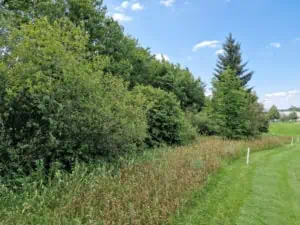Biodiversity projects for beginners
The view falls on a piece of mown rough – between two tees. “We have newly introduced the rough here. To be honest, the feedback was much better than expected,” says Manfred Beer, Headgreenkeeper at GC Isarwinkel in Bavaria, Germany. The designation of new rough areas on the golf course is part of the strategy to operate the entire course in a first-class manner from an ecological point of view. The diversity of species in extensively maintained areas is significantly higher than in strictly mown grass.
The chairman of the Bavarian Greenkeeper Association is one of those who have been following the topic of ecology on the golf course for a long time. “The playing surfaces are the mandatory program; everything else is the freestyle part,” he sums up with a smile. He has brought the golf course to the Gold Award at Golf & Nature, participates in the Blühpakt Bayern project and maintains active contact with the Landesbund für Vogelschutz.
Tips for beginners on the topic of biodiversity
What are the most important tips for all those golf courses that want to do something to enhance biodiversity on the course, but don’t have a lot of financial resources and possibly not too much knowledge in the field of ecology?
For Beer, the journey begins in the mind: knowledge costs nothing at first. “First of all, the greenkeeper has to know his areas.” Awareness of where the soil is rich in humus and where it is sandy or gravelly, knowledge of the sun’s incidence and precise observation of the flow of play – all this creates a complete picture of the golf course at the start. Projects can only be developed in a meaningful way if this is available.
For Beer, classic starter activities are the creation of a pile of dead wood and a pile of reading stones. “This can also be combined well to create natural transitions. But it’s important that the space is sunny.” With a fallen tree and a few reading stones, the amount of material required is manageable.
But you can also leave deadwood standing, is his second tip. And there won’t be any costs. Dead trees are used by a variety of organisms. Woodpeckers, insect larvae, deadwood fungi and bacteria – they all ensure that deadwood remains integrated into the biological cycles. More than 600 species of large fungi are involved in decomposition and over 1,350 of the 6,000 beetle species in Central Europe live on deadwood. Many plant and animal species are highly dependent on certain decay and decomposition phases of wood for their way of life. For example, fungi, lichens, mosses and many insect species, such as ants and butterflies. The majority of around 1,000 wasp and bee species need old and dead wood.
Proper disposal of clippings
The second topic close to the Head Greenkeeper’s heart is clippings. “If I simply throw the clippings into the rough areas or mulch them, it’s mainly nettles that develop.” The development of high-quality rough areas is out of the question. “In this case, it’s better to collect the clippings centrally with a trailer or in baskets and dispose of them properly once a week.” From then on, significantly more mosses, herbs, flowers and grasses have the chance to develop on the areas. Instead of sowing seed immediately, Beer first of all focuses on observing the area. “If you look closely, you can quickly get a feel for what is developing on a wet meadow or in a dry area. It is often enough to give the area time to develop itself first.” A process that requires time and patience, but no investment.
With a view of a hedge that separates the GC Isarwinkel from a road, Beer talks about the next stage. The enhancement of hedgerows through multi-level design. “We had a whole row of beech trees here. We then planted regional bushes in front of them and developed a third level of rough strips to delimit the fairway.” All that is needed is an excavator to roughen the ground. “The cuttings for the bushes are really cheap to get.” However, it is crucial to pay attention to the food supply for insects and birds. “Ideally, I have a row of bushes and trees that provide food from spring to fall.”
No, Beer concludes, the realisation of many projects for more biodiversity on the golf course is not a cost factor. “The focus is on commitment and knowledge.” As far as the second aspect in particular is concerned, he also refers to the local nature conservation associations. “When I first became interested in the topic, I asked the Landesbund für Vogelschutz. They were extremely helpful there.” In his experience, every golf course could use this source of information. Because here, too, there are no costs, you just need to be interested.









